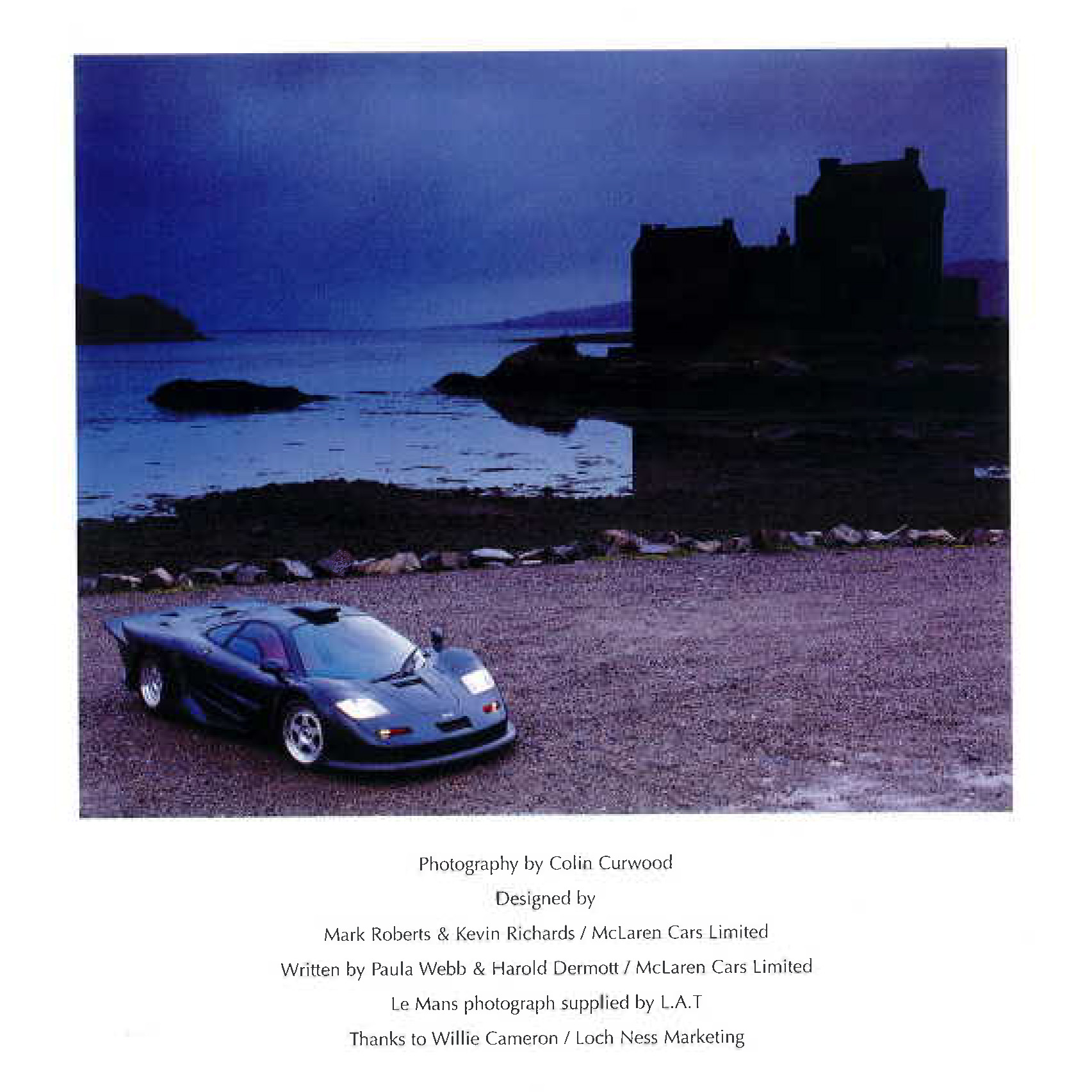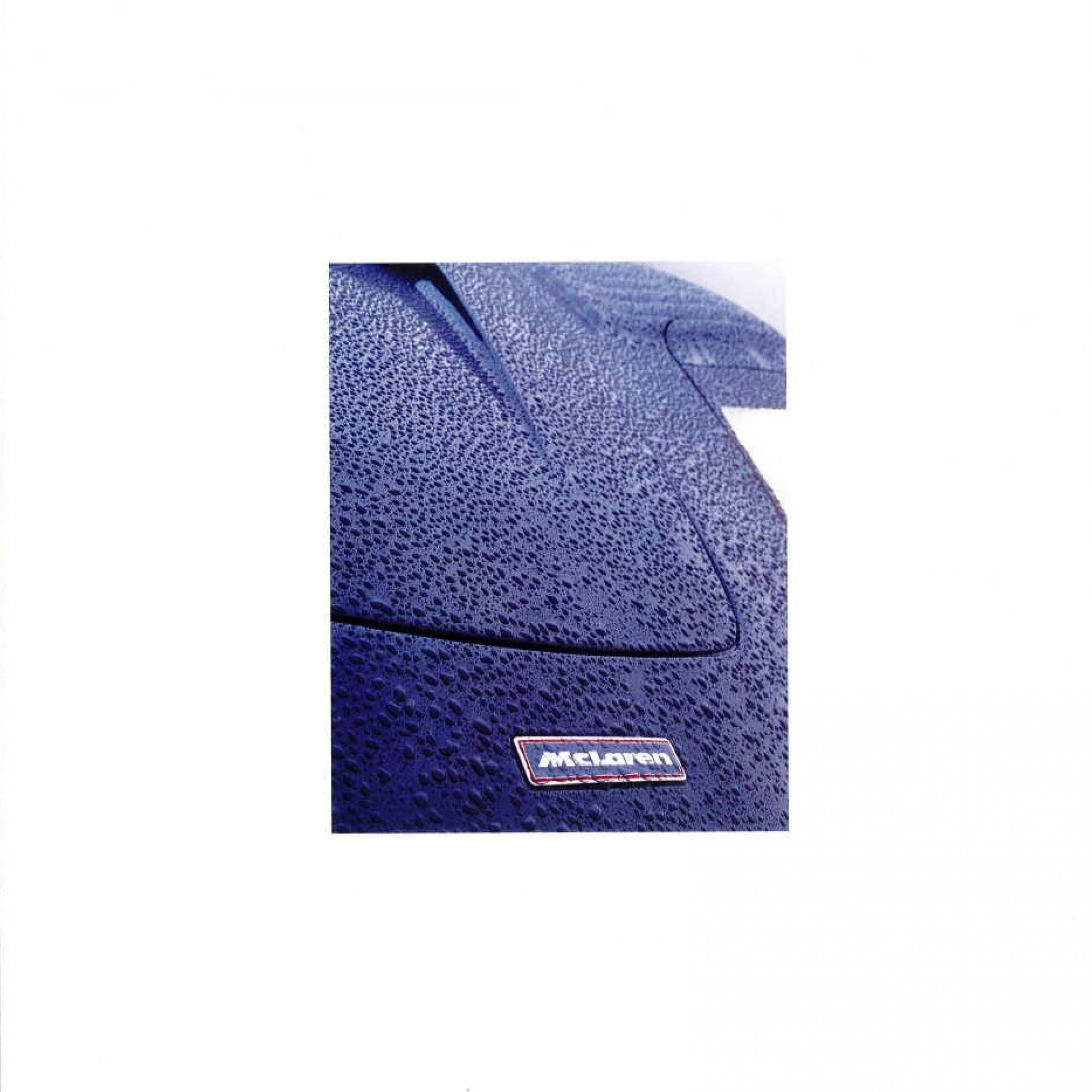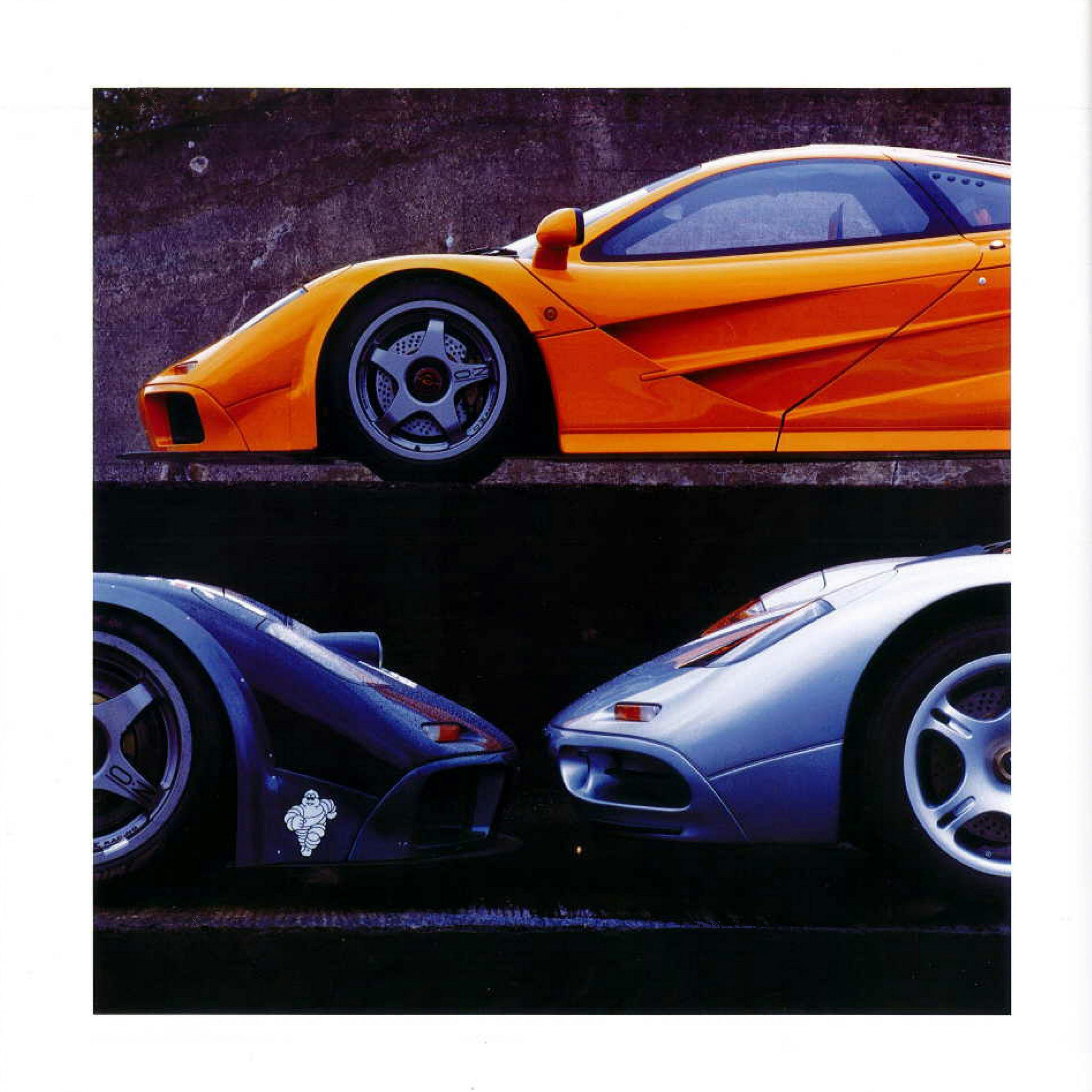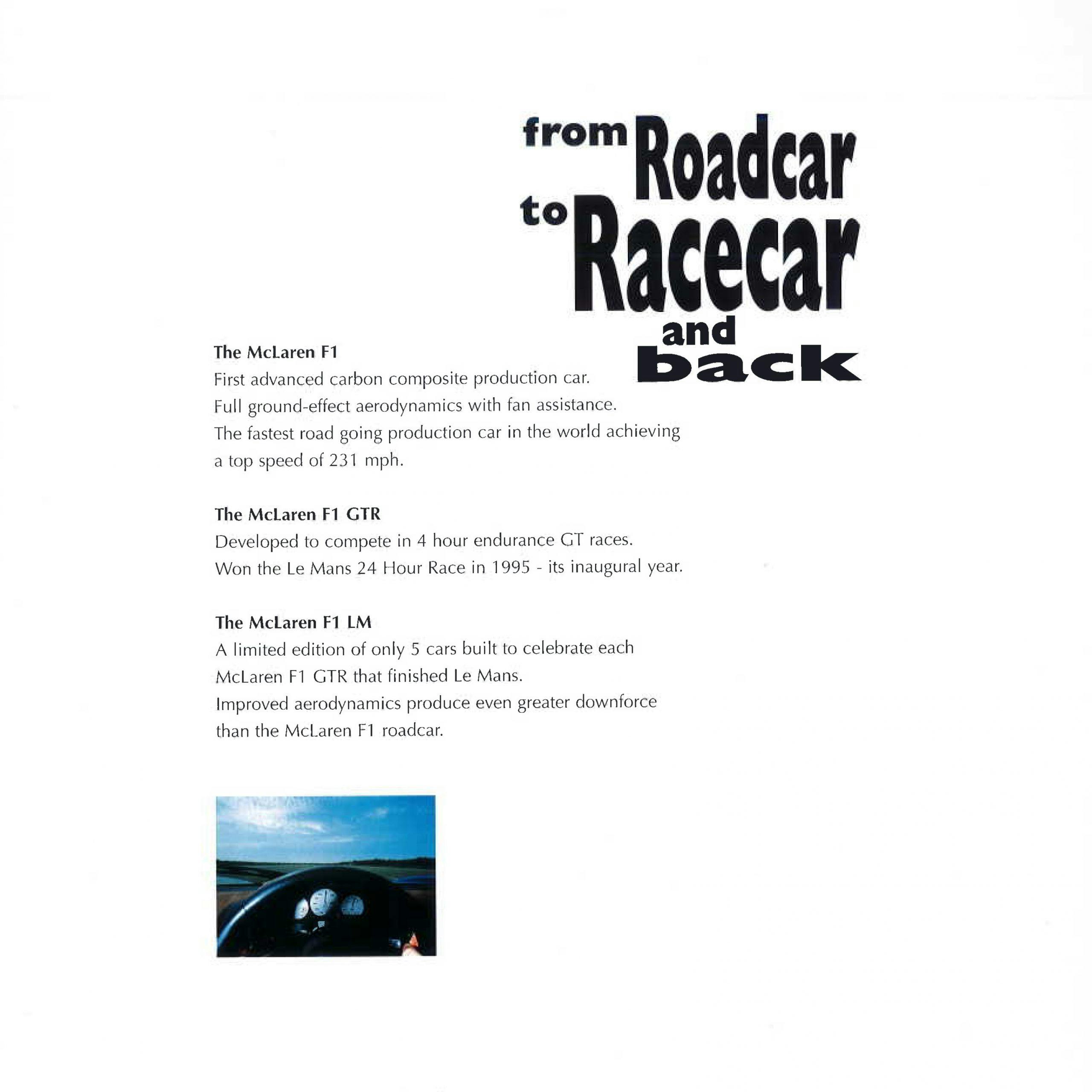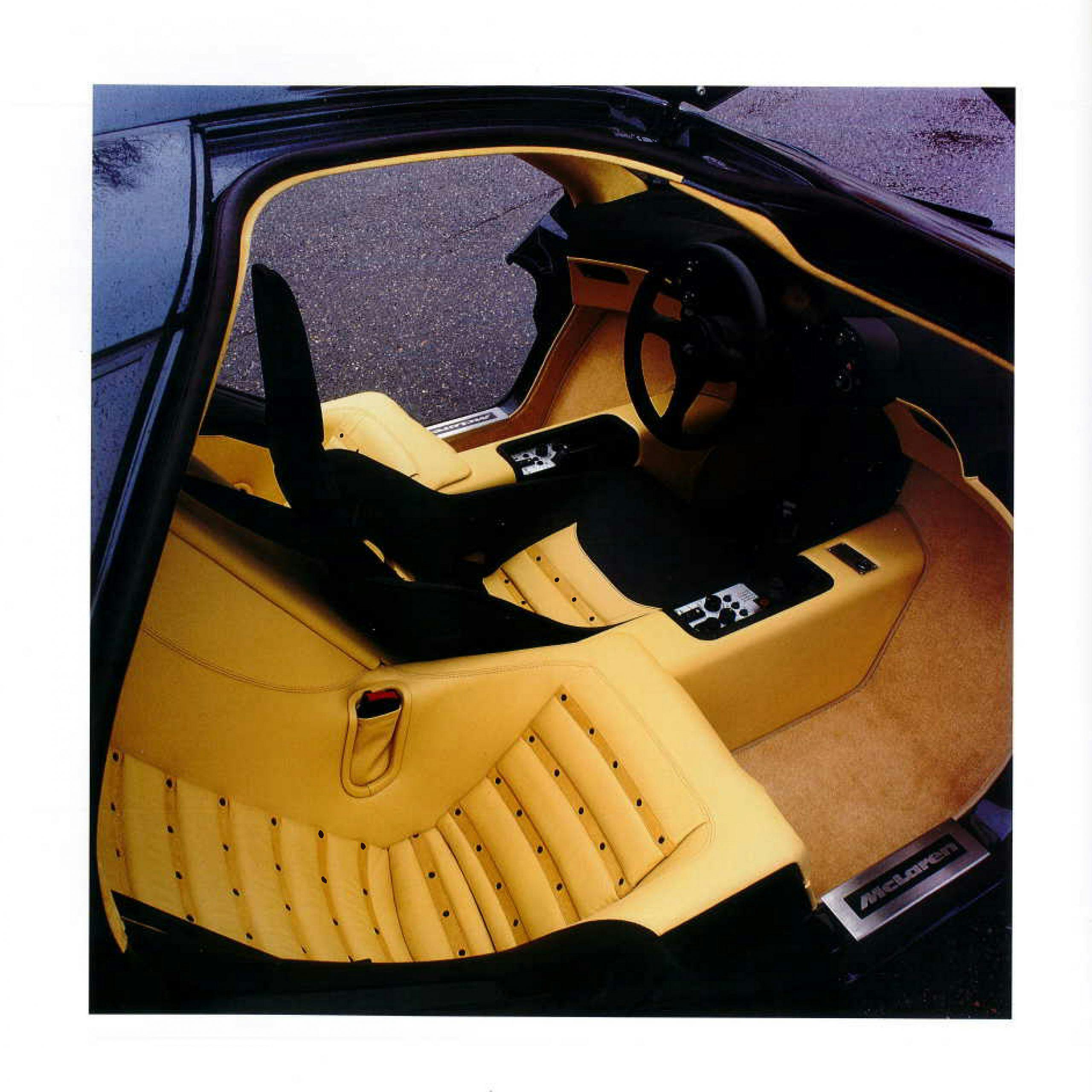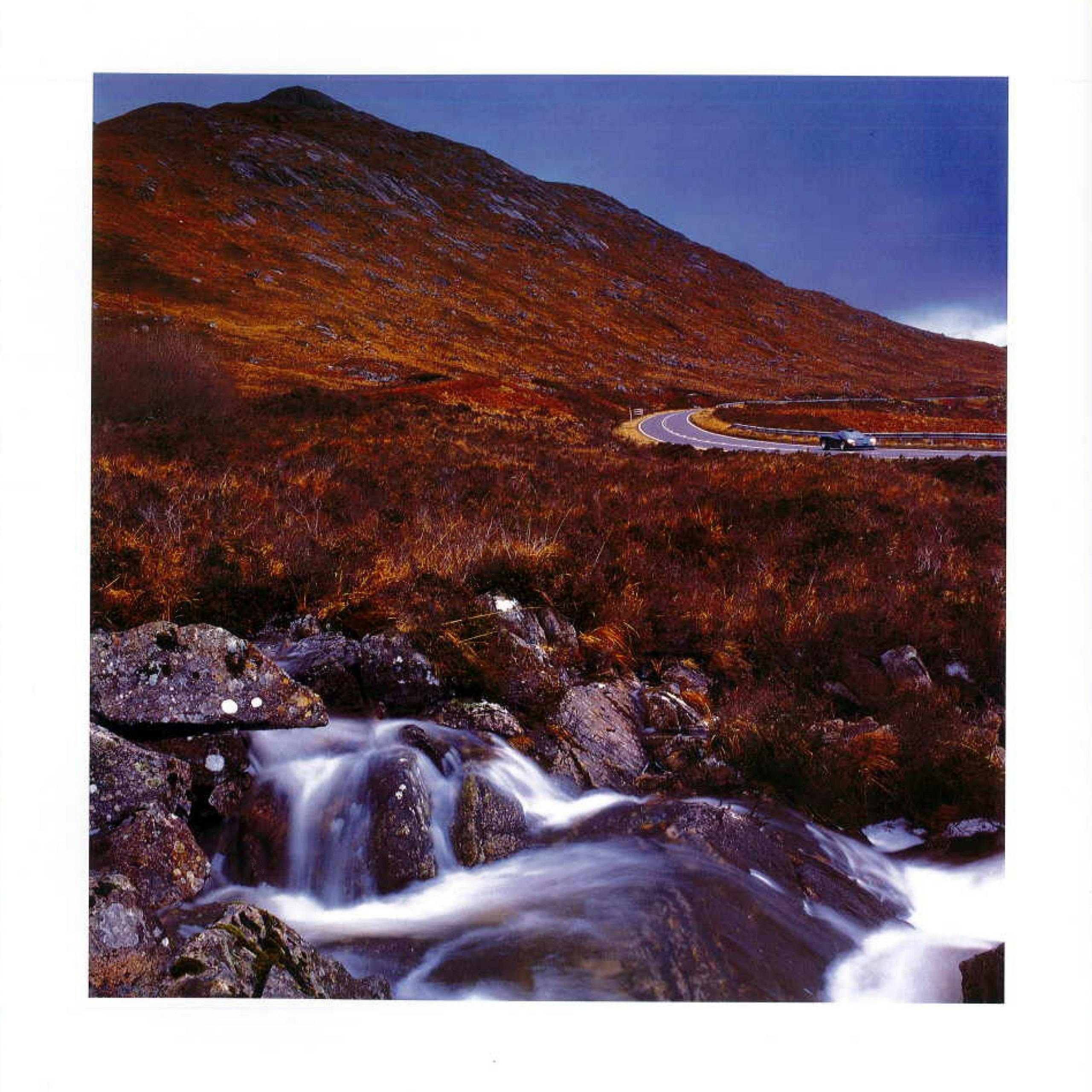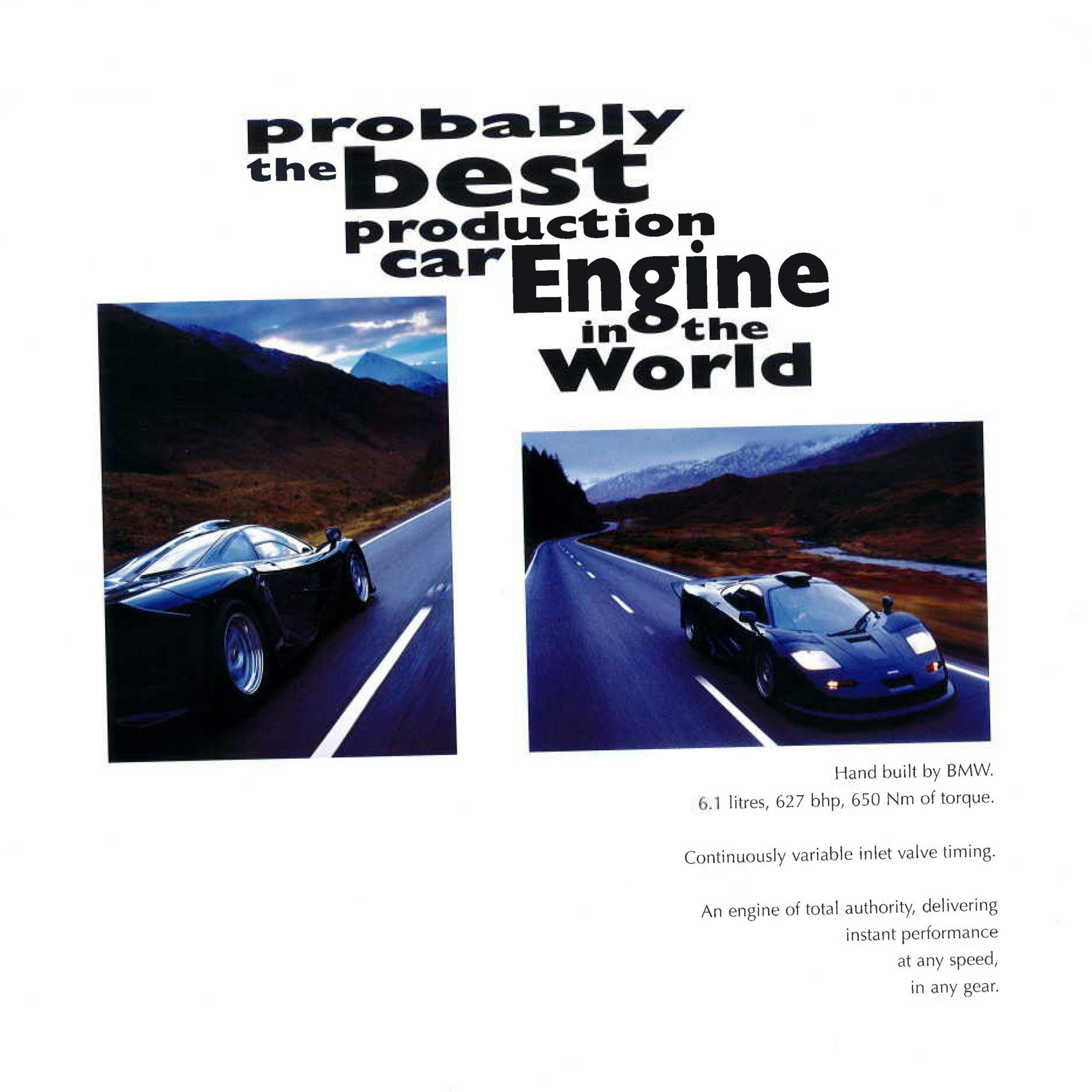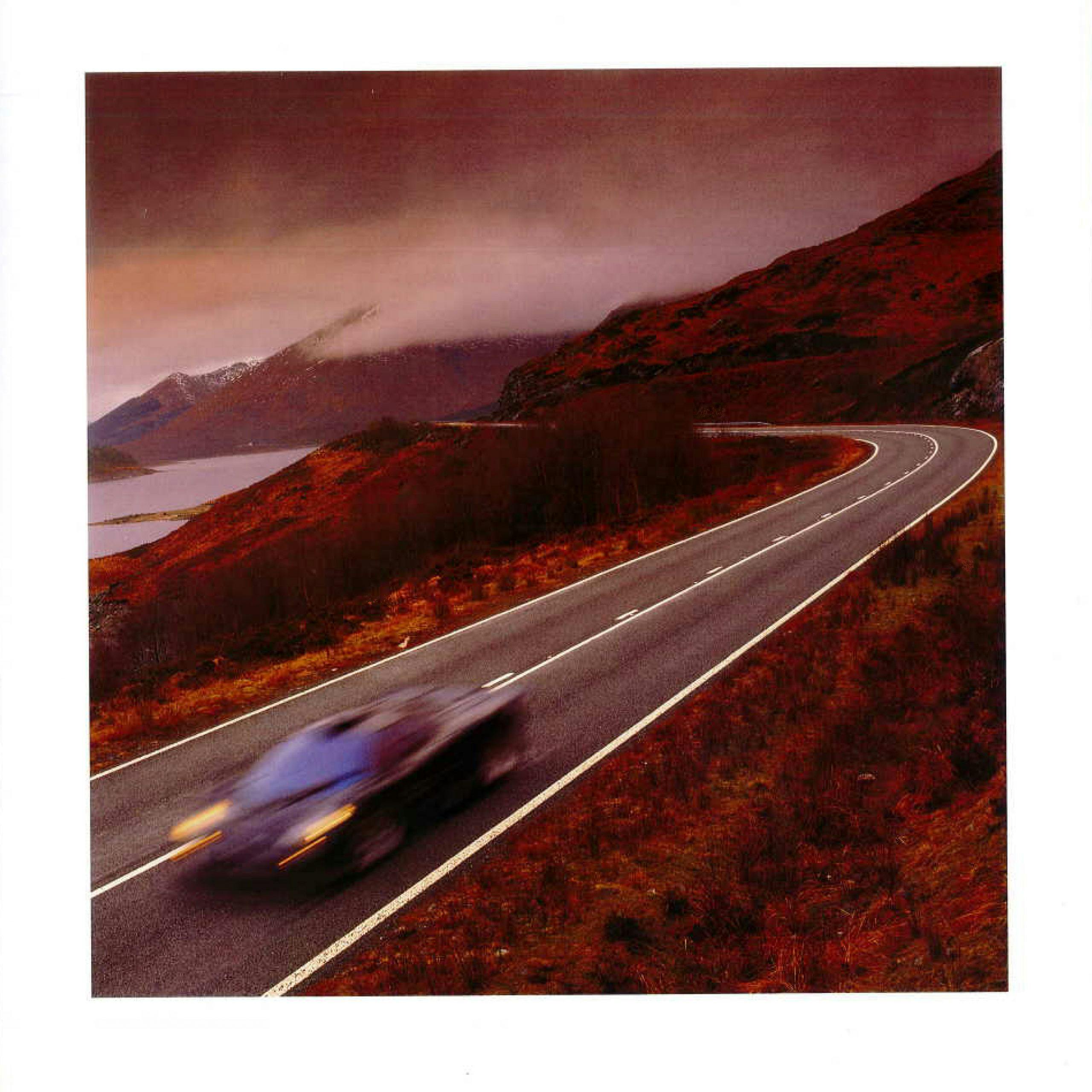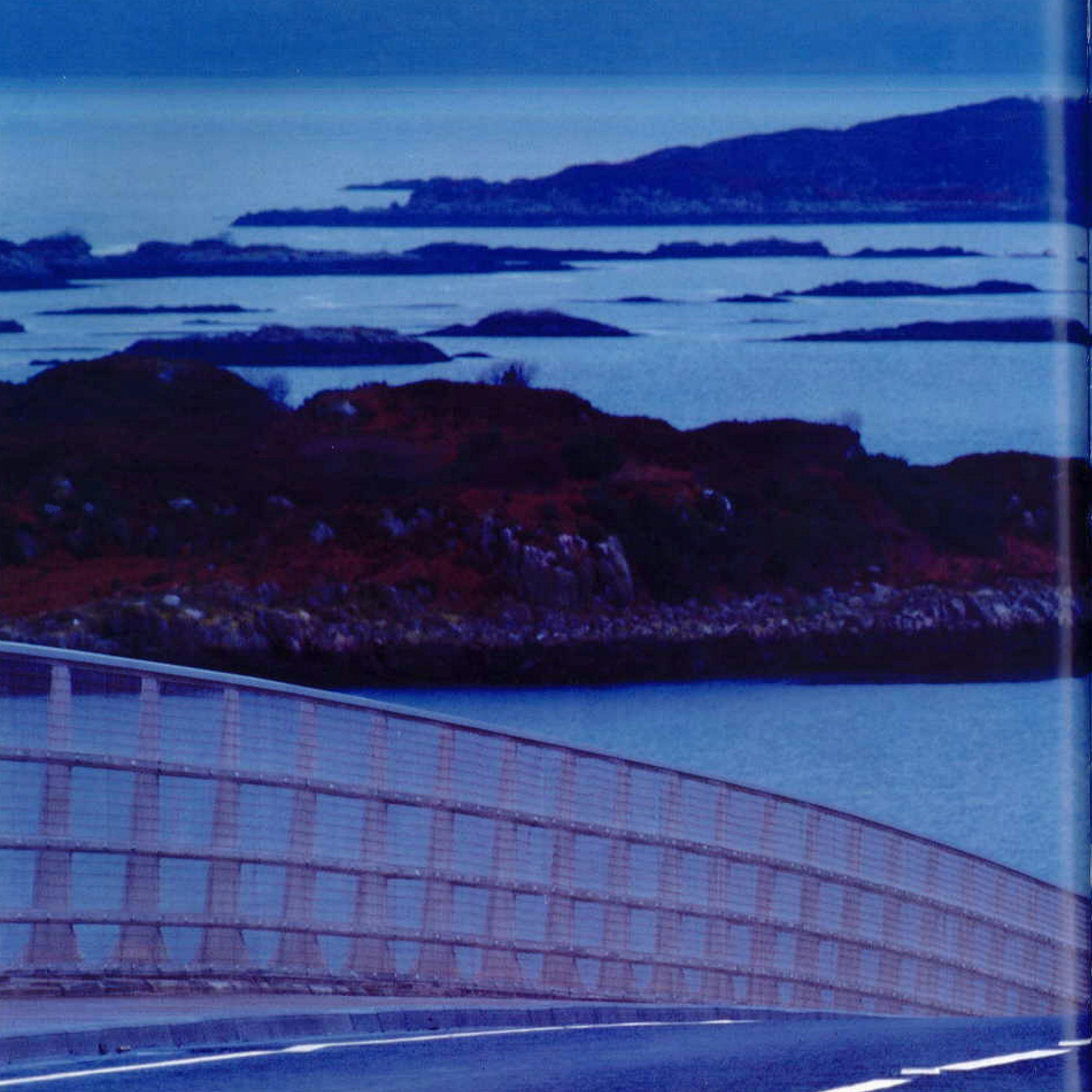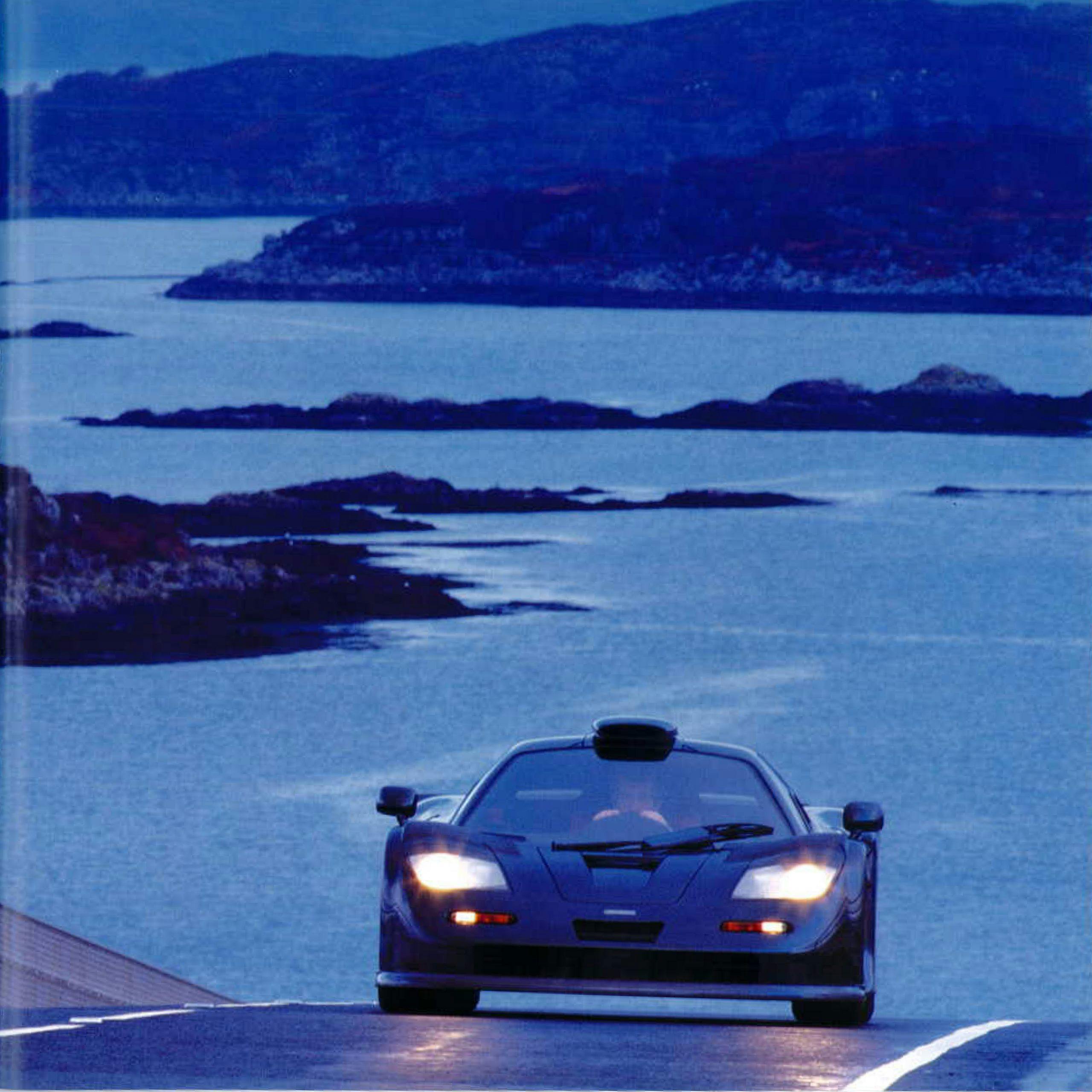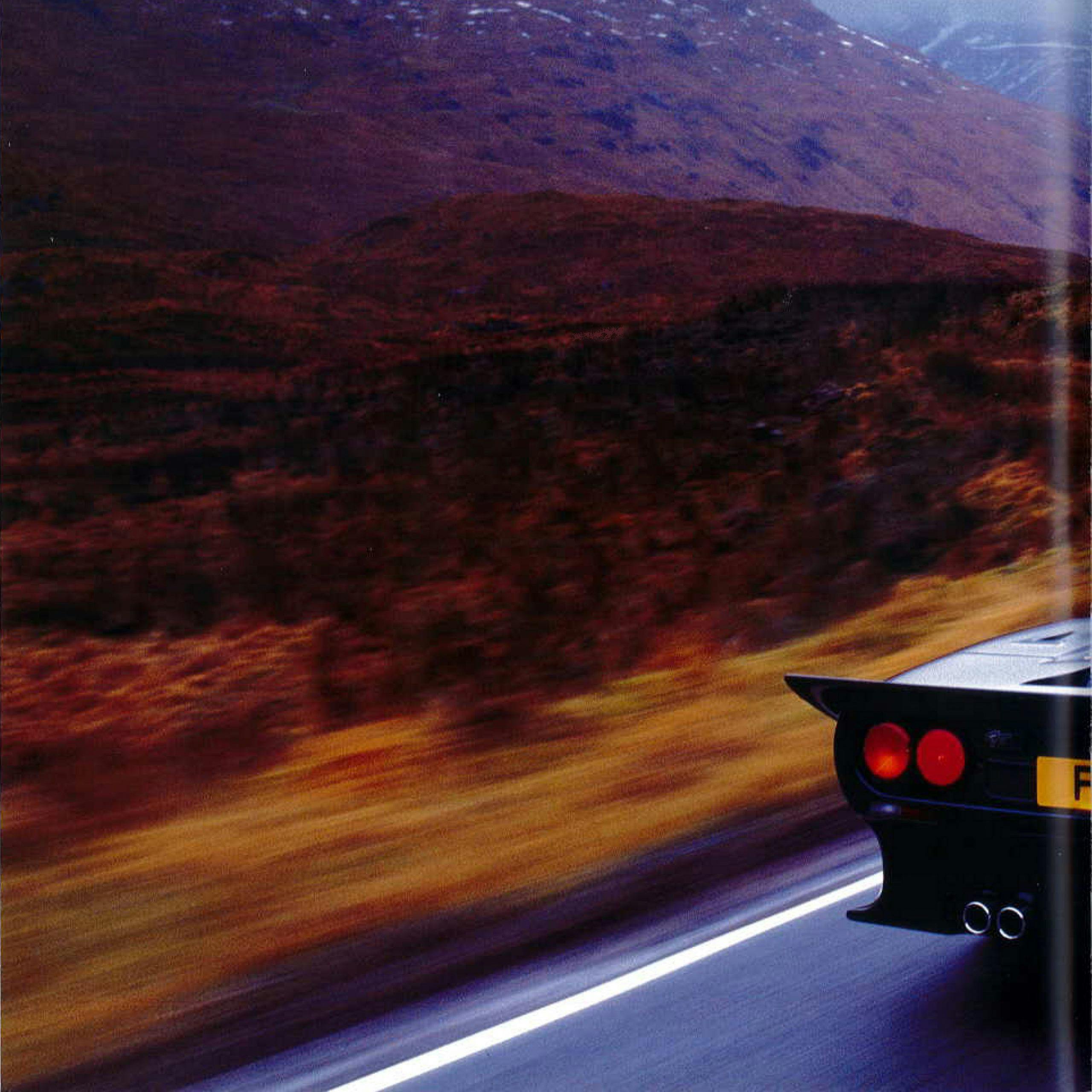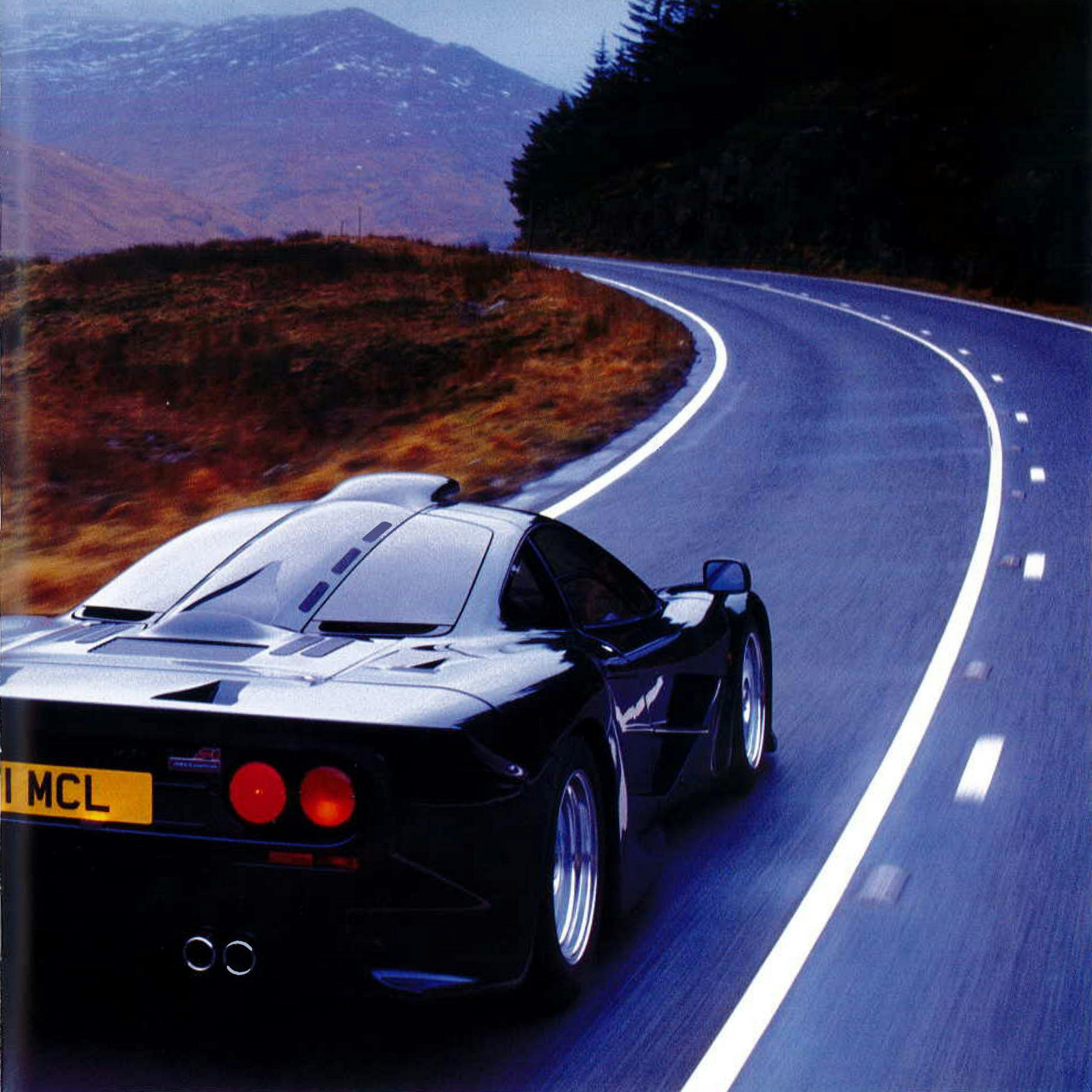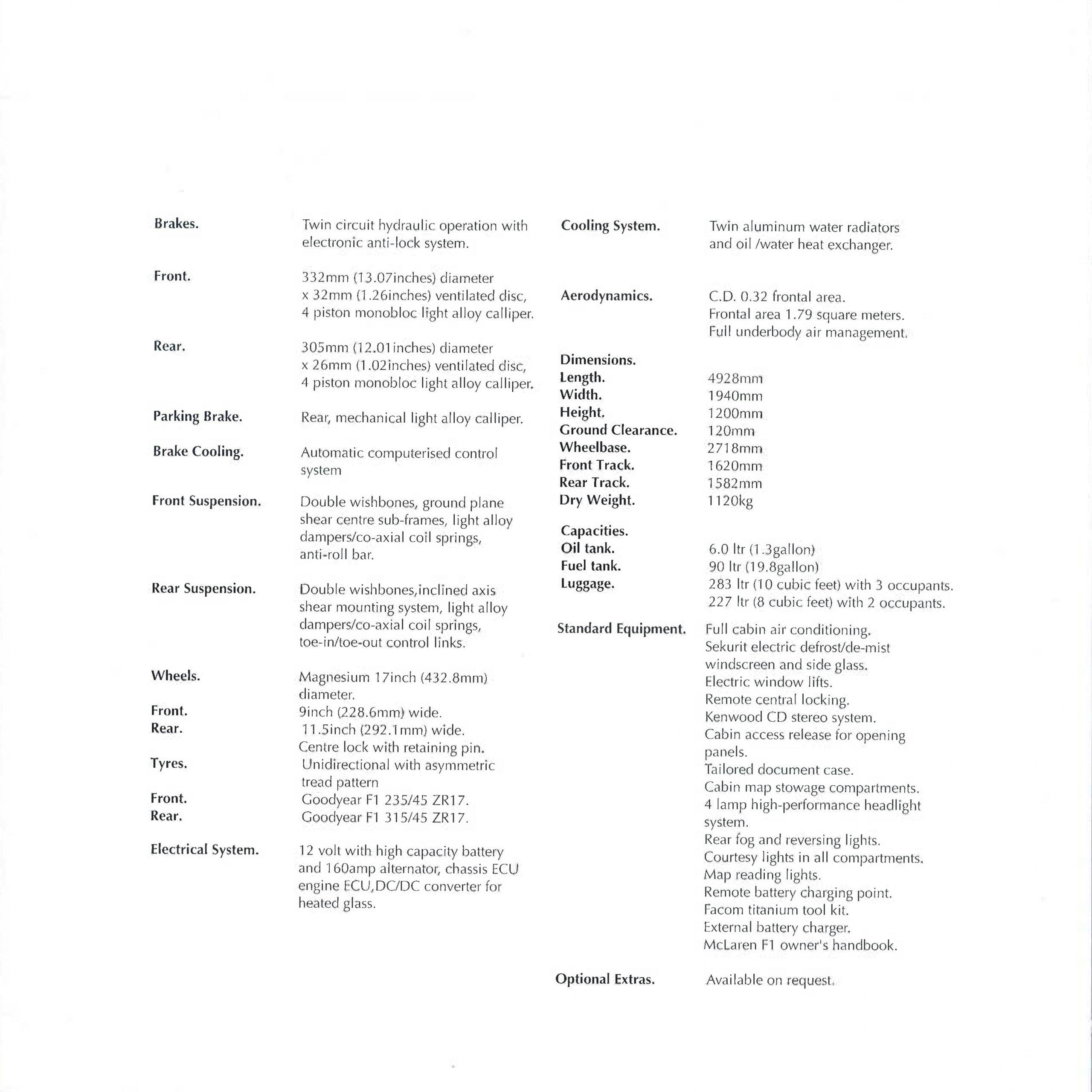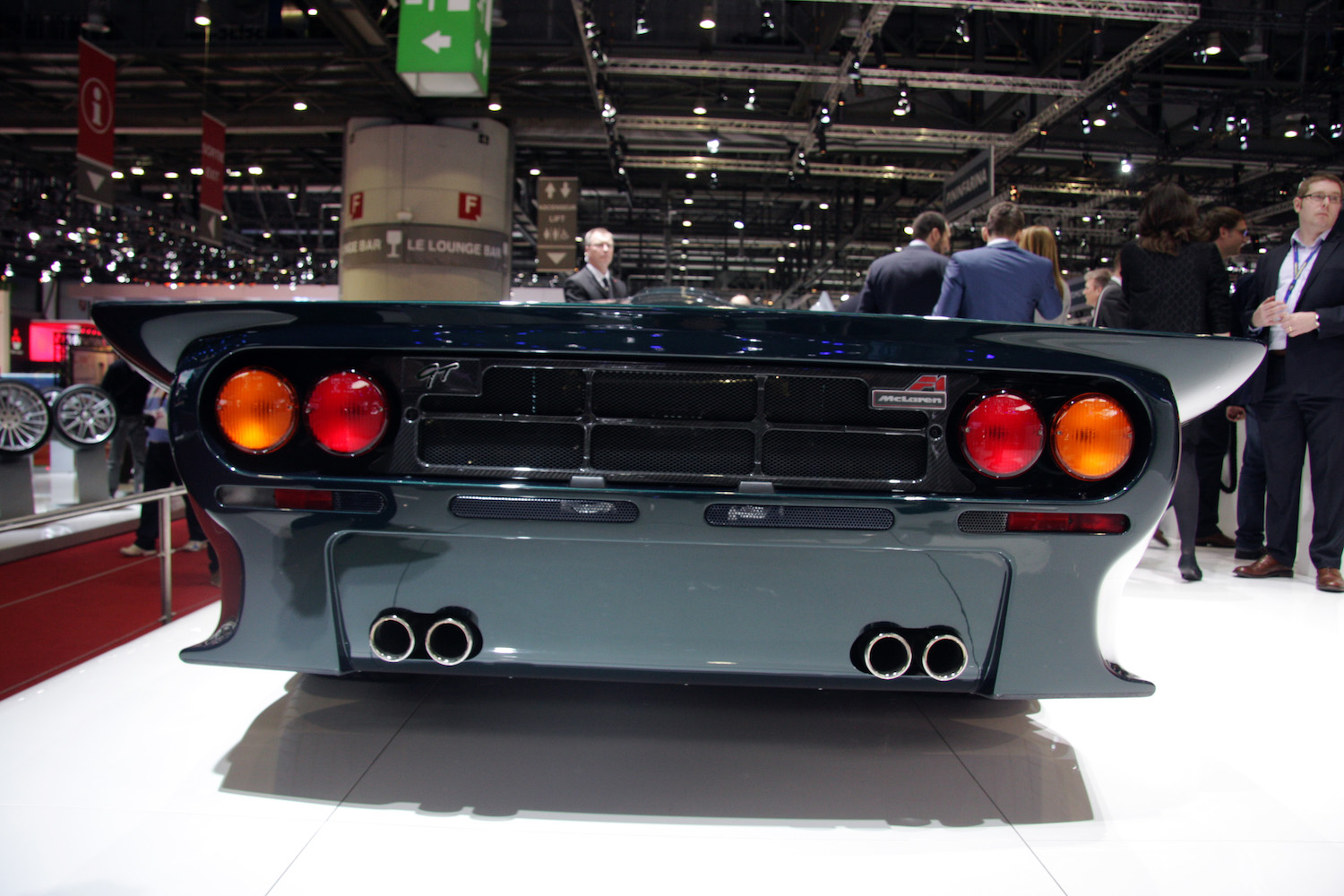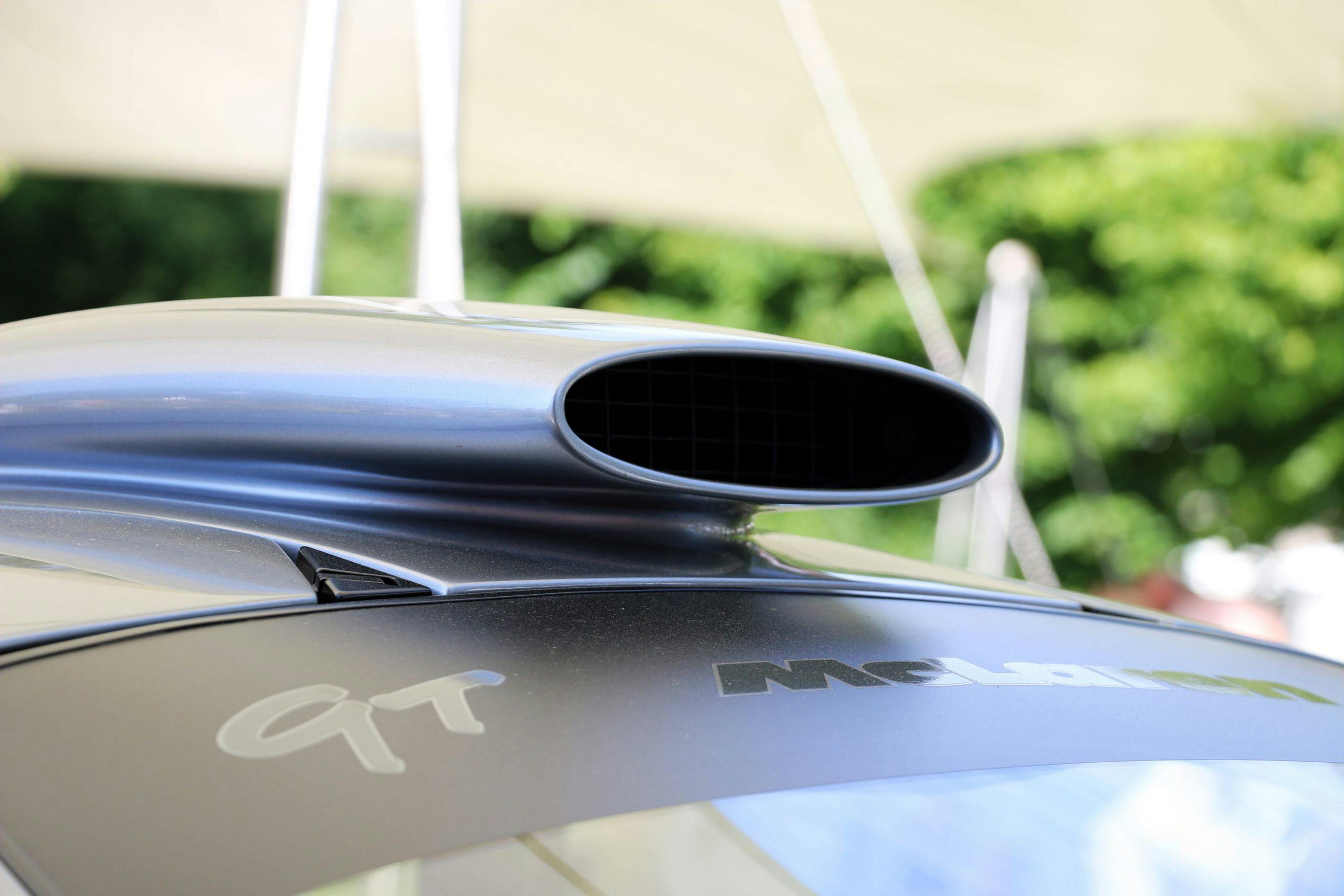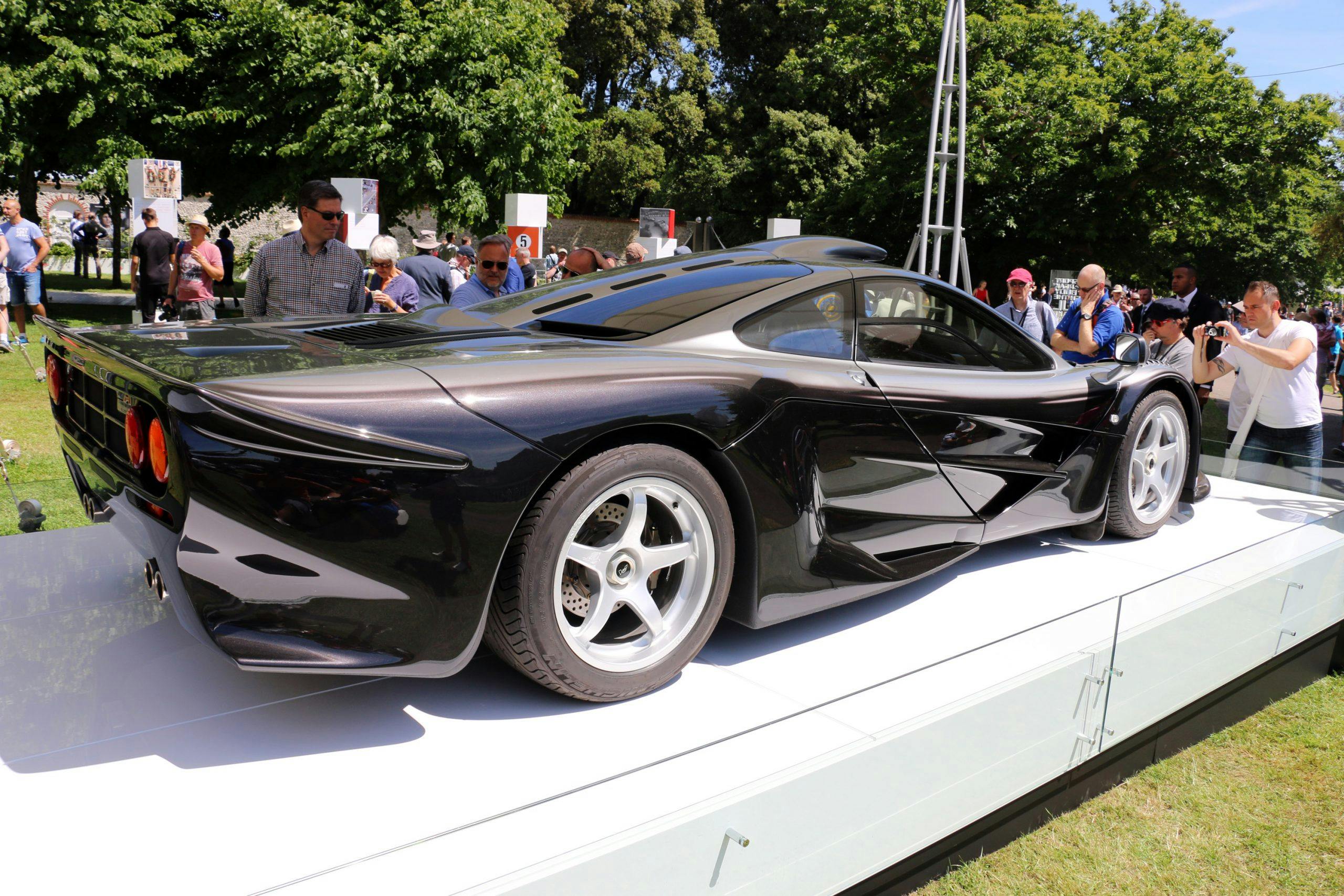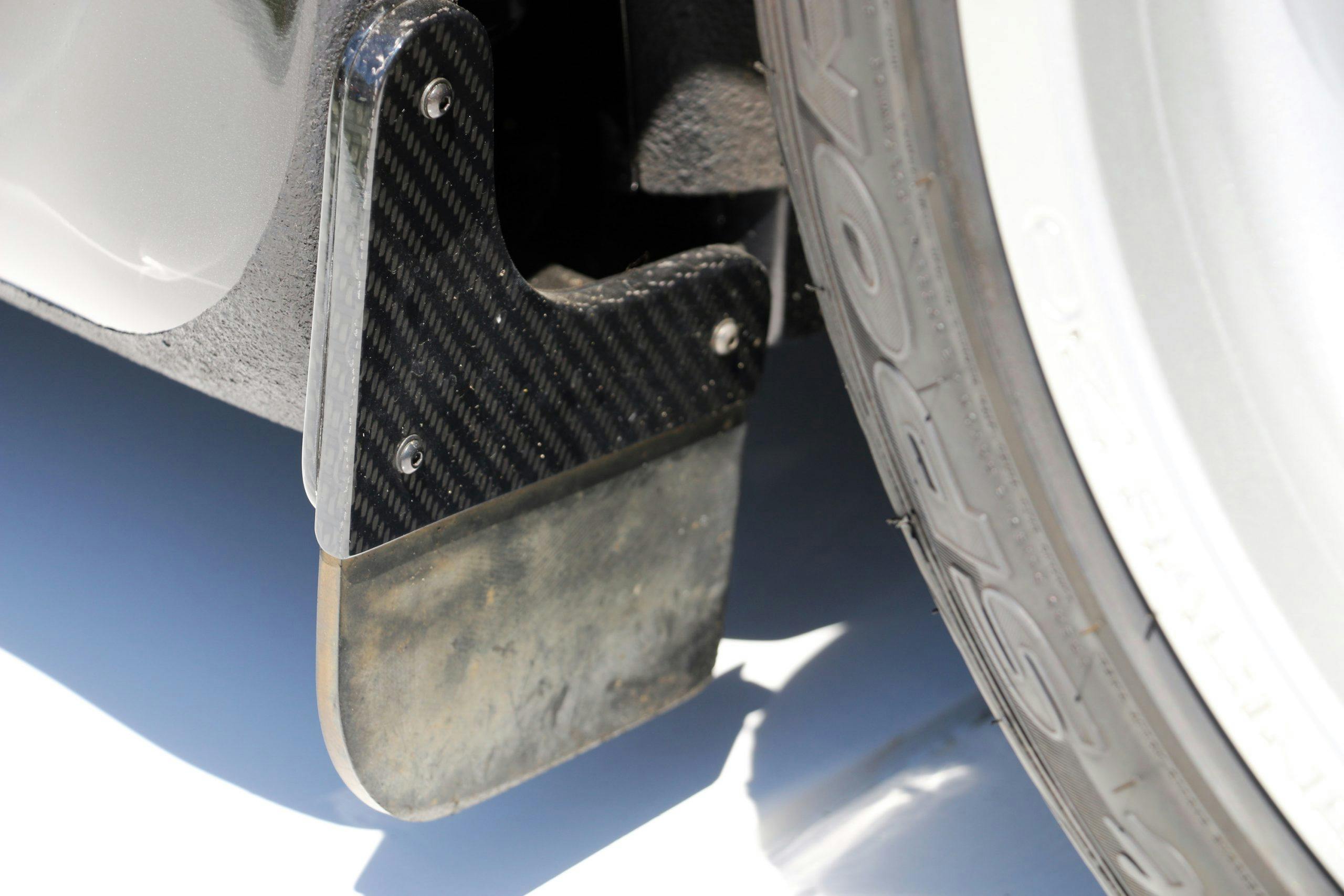Media | Articles
The full story of the McLaren F1 GT and the world’s greatest car brochure
In 1997, McLaren’s Colin Curwood, Mark Roberts, and Kevin Richards got a budget to spend three days in the western Scottish Highlands with a brand-new F1 prototype. Their mission was to create the world’s greatest car brochure for a car that didn’t really need one. How did Gordon Murray endorse such a ludicrous project? To answer that, we have to go back to the race tracks of 1996, where Germany got a sudden head start over England.
War
On May 24, 1996, Gordon Murray made a sketch of a red car labeled “McLaren F1 Evolution”. It had a long tail and a longer nose to produce more downforce, an upgrade triggered by Porsche’s acceptance into the BPR Global GT Series with its purpose-built 911 GT1. Porsche’s new race car debuted at the 4 Hours of Brands Hatch on 8 September, 1996, with Joachim Stuck and Thierry Boutsen comfortably taking the crown in front of the Harrods, Gulf, and West McLaren F1 GTRs, which were still very much based on the regular road car at that point.
Murray wasn’t happy, for reasons detailed in the F1 book Driving Ambition:
“[Porsche] got away with running rose-jointed proper-geometry true road-racing suspension, on a car which we felt was not genuinely available for sale. We didn’t like what had happened—because we didn’t feel it was at all within the regulations, but we had to face up to it. To comply with the regulations as written, we had to build a new road car, sell one a month before the first [‘97 FIA GT Championship] race, have dealers, brochures and parts back-up for it. I went to Ron [Dennis] for a budget to do just that, and actually started the wind tunnel program before I’d got the go-ahead.”
Marketplace
Buy and sell classics with confidence
Well, of course he did.
Alongside the ten ‘97 F1 GTR racing chassis, McLaren was also building three examples of a homologation road car known as the F1 GT, based on the GTR’s modified bodywork. These “Longtail” F1s meant even more headaches for Woking, since Murray just wouldn’t compromise on quality. More from Driving Ambition:
“Until the Porsche had been accepted, I’d intended a straightforward ‘96-type GTR update—now we had to embark upon a major crash program to develop not only a new racing car, but first a new road car model to legalise it! We were determined to do it all precisely to the letter of the regulations, in the spirit their original authors had plainly intended.”
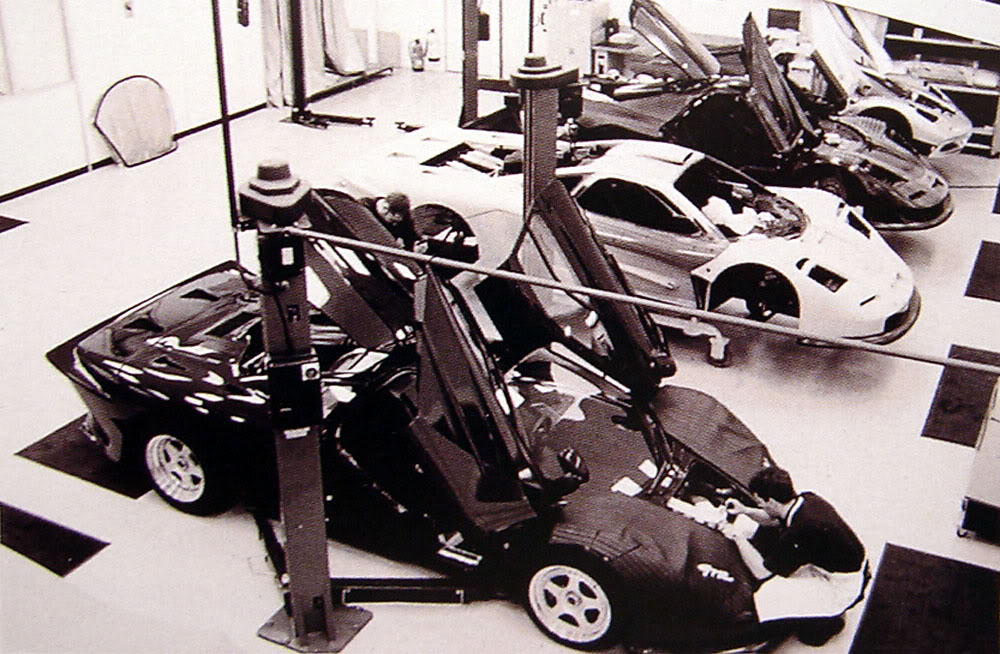
The hidden trio
McLaren built its prototype “Longtail” F1 GT road car, the Silverstone Green example with chassis number 56XPGT, eight road cars before the second F1 GT, the Sultan of Brunei’s Black-plus-10-percent-flare-exterior known as 54F1GT, and the originally Dark Burgundy 58F1GT that went to the ZAZ Automotive Museum in Japan. (When the latter car arrived at ZAZ, it was parked next to F1 LM2, one of the five special F1s built to celebrate McLaren’s 1995 Le Mans victory.)
There was no real rush to build the GT road cars right away, since the FIA had changed homologation rules for 1997, postponing the deadline until the last day of the year. This move certainly helped Porsche and Mercedes-Benz, but it also kept Lotus and Panoz in the game.
With the McLaren team still furious about how the 1996 BPR Global GT Series progressed into the 1997 FIA GT Championship, Gordon Murray turned to former McLaren employee #9 and graphic design master Mark Roberts. Murray’s plan was to throw a valid F1 GT road car brochure on the FIA’s table, one that indicated such clear evidence of a road car that it would make representatives from Porsche and Mercedes-Benz blush. Here’s how that process went in 1997, as described by Roberts:
“Gordon said: “Go do a brochure for the GT”. But we were only going to build a handful of Long Tail road cars. Porsche and Mercedes-Benz went into an all out assault at Le Mans, because we won there in ’95, and we kept winning races in ’96, so they really wanted to make their mark. So what Gordon did was make this brochure for the customers, but more importantly, it was so that when he went to the FIA meeting with Porsche, with Mercedes and all the other competitors, he could say “Okay guys, we got all the specifications for your race cars, where is your sellable road car? Where are the cars you’ve now modified to make it into your race cars? Because here is our road car. You can buy one of these! Here’s the brochure, here’s the price list!.” And then they were stretching their heads…and that’s Gordon’s sense of humor. Just to wind them up…”
The F1 GT brochure was designed by Mark Roberts and Kevin Richards, and photographed by Colin Curwood in medium format. Here’s how Roberts remembers his drive in the prototype in the northern UK:
“56XPGT was the first one we built. And literally, it was done, and a week after, I took it up to Scotland. Gordon was so funny…he said “Here the budget, go on and do it. But you can’t take it abroad, it’s too dangerous, so keep it in the UK…” And I said okay, I’ll arrange it. And I told him I’ll be alright with it. And then the day before we were leaving, he came back asking “Are you sure you’re alright with this? Because we just built this car, and it’s the only one we got. You’re taking it up to Scotland, and it’s snowing up there at the moment. Are you sure you’re comfortable with all that?” And I told him: “Oh, thanks for the support, Gordon!”
“I did a little storyboard for what we are going to do, because we only had three days up there. We also wanted somewhere safe to put the car overnight on the way up. Harry, one of our drivers, had a friend whose son was a fighter pilot, flying a BAE Systems Hawk. In fact, the next year, he joined the Red Arrows. So, we went up to RAF Leeming in Yorkshire first, and stayed over there. I thought it was a great opportunity for a photoshoot, so later on, we did one there with a Hawk. They had Tornadoes and Hawks there back then, and when we took the Longtail up, we went for the meteorology briefing in the morning to see what the weather will be like in Scotland. And when we got into the car, all of the pilots came out, because they wanted to look at it of course. Meanwhile, Colin, Harry and I wanted to check out the planes…
Once in Scotland, as usual, the weather was appalling. We had to take advantage of any little brightness. You know, five minutes of light: “oh my god…and then I’m like no-no-no, we want to be in that direction…And when we were tracking the car, we had a BMW wagon we were taking turns in, Colin hanging out of the window saying “closer, closer, closer!” – In the end, we realized we’re not going to use the trailer, because getting this thing in and out on ramps was just ridiculous. So we just drove it, and it was fine! In fact, it was absolutely great, and really reliable. We shot it on the Skye Bridge, and nobody has used it for anything other than that since. We never even planned to get some of these shots. It was on our way back to the hotel, in the evening, and Colin went “get the car out of the trailer!”
I kept it as a really back-to-basics brochure. Just some nice features, and Collin’s photos were lovely. He used to do a lot of that, looking at a line, and then doing an offset line. The place was called the Five Sisters of Kintail, up in The Isle of Skye, and it just looked really great.”
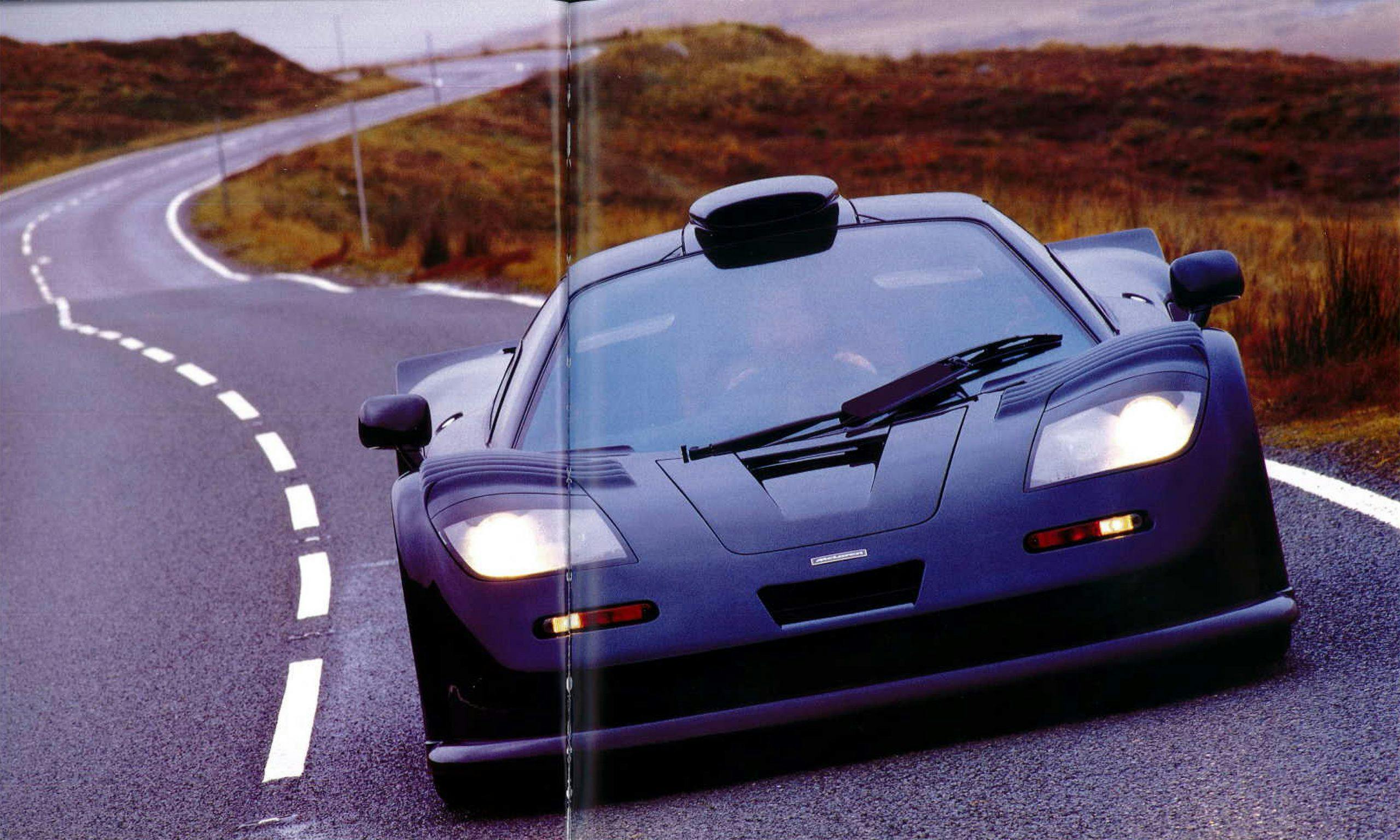
Think about this three-day adventure for a moment. First of all, it’s a very British move. But perhaps even more impressive is the end result given the circumstances. Rainy, gloomy Scotland hosting a priceless prototype driving on its twisties, chased by a BMW wagon with a photographer hanging out of its window. No studio, no Photoshop touches, just some rather bulky medium-format camera gear, and film that on the move, really craves more light than even the most basic of today’s digital machinery. Yet the product, this brochure that was made out of principle to prove a point, is absolutely beautiful, even in this rather low-resolution scanned form.
The GTs today
The first roadgoing Longtail, McLaren’s Silverstone Green 56XPGT, never left Woking for longer than a weeks-long promotional tour. It was last seen in 2015 at Geneva, when the 675LT was new:
When this car was up for the photo shoot in Scotland, it still had a red interior, but McLaren quickly changed it the current cream one, for reasons Roberts explained:
“The Scotland shoot featured the car with its original red interior fresh off the production line. It never really suited a GT car so as soon as we got back I put together a more appropriate interior for a GT. This became the template for the other GT cars too.”
Speaking of the other two GTs, the Sultan of Brunei’s flared black one (chassis 54F1GT) was once photographed wearing temporary plates 049PF while being shipped to Southeast Asia along with the royal family’s three F1 LMs, and then with British plates BQ 7551 once there. While possibly never driven, this car had a red interior that last time it got snapped. The third GT, the originally Dark Burgundy example sold to the ZAZ Museum in Japan (chassis 58F1GT) went back to McLaren Special Operations a few years ago, emerging as a black-silver two-tone wonder that was first presented publicly at the 2015 Goodwood Festival of Speed.
Rewinding to the 1997 racing season, Mercedes-Benz only announced its entry into the F1 GT Championship about a week before the first race at Hockenheim, held on the 13th of April. It wasn’t the best news for McLaren after Porsche’s coup with the 911 GT1. But the reality was that, based on a carbon-fiber monocoque made by Lola, AMG put together its CLK GTR in just 128 days after the decision was made to enter the 1997 season, with some help from Ilmor in the engine department. It was a rapid pivot, and to make matters worse, Mercedes acquired a ‘96-spec McLaren F1 GTR from private team Larbre Compétition, only to re-body chassis the F1 GTR with Mercedes’ own panels, so the team could develop the CLK GTR’s aero package. Despite the upcoming McLaren-Mercedes partnership, this was all done without Woking’s knowledge, at least until driver Bernd Schneider crashed the CLK GTR mule, and the press got the scoop on the story.

After it was satisfied by the downforce levels and new sequential gearbox of the initial 1997 GTR prototype, 19R, McLaren built nine more Longtail race cars to answer the teams’ calls. Eleven races later, the season ended with AMG-Mercedes winning the GT1 Championship thanks to Bernd Schneider, who pushed Team BMW Motorsport’s F1 GTR back to second place.
With that and the McLaren-Mercedes deal on the table, 1997 was McLaren’s last GT racing season with the F1, while privateers continued with some of the ‘97-spec cars all the way up until 2007. Since then, a number of Longtail GTRs have been converted to road-legal form by Lanzante Motorsport and Gordon Murray Design. The list includes prototype 19R, the car famously pushed to its limit by Kenny Bräck in front of a large audience at the 2014 Festival of Speed:
A Longtail that’s no LT
As luck would have it, McLaren F1 GTR 19R is for sale now. Still wearing its launch livery, it’s offered in roadgoing configuration by Tom Hartly Jr. What is such a car worth these days? Hard to say, because while F1 prices are through the roof, Longtail race cars tend to change hands at lower sums than the original road cars. However, this is a GTR prototype, and the other one that’s not the Le Mans-winning 1995 01R car retained by McLaren is Nick Mason’s 1996-spec 10R. And he is not likely to sell it anytime soon. Not too long ago, Tom Hartly Jr. also sold the road-converted 1997 F1 GTR 27R, and that Lark-liveried car didn’t break any sale records.
Either way the 19R deal goes, its future owner should insist on receiving a GT brochure from McLaren, as well. If you think about it, one of these works of art was used by Gordon Murray to shame Porsche and Mercedes-Benz at an FIA meeting, while a second and a third went to Brunei and Japan accompanying homologation specials that weren’t going to be driven much, if at all. Three F1 GT cars in total that Driving Ambition summed up like this:
“The road-going McLaren F1 GT in effect emerged as a very highly-specified, luxuriously-appointed ‘stretch limo” version of the world’s fastest production car. Even the normally exposed carbon-wave surfaces of the longitudinal chassis beams were upholstered in leather in this version, and apart from its extended nose and tail bodywork and rear wheel-arch extension spats it complied in every way with the latest production F1 standards.”
Connolly leather, that is, according to the exquisite brochure.
